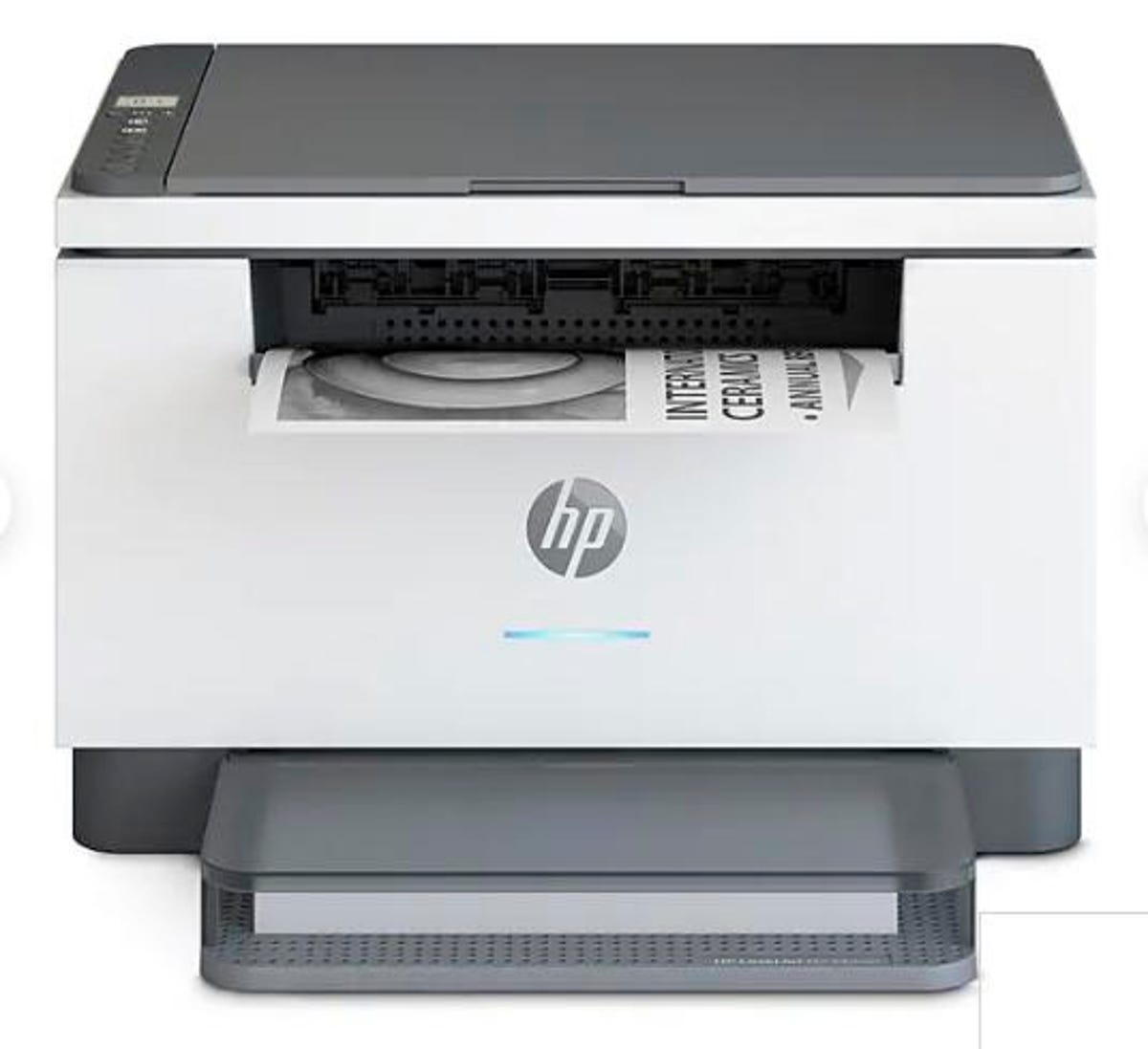[ad_1]
Earlier this week, I made the case for scanning all of your documents. I showed you that not only having a way to store and retrieve tax documents, but also being able to get to all your critical business documents online, could be of great value.
All that is true. But sometimes you still need to print something.
Printing is dead, I’ve been told. And, to some degree, I bought that argument. After all, I don’t print out nearly as much as I used to, back in the days before we had tablets and oversized smartphones, and that probably applies to many of you, as well.
But the laser printer market is still growing. According to market researcher Industry Research, the global laser printer market is estimated to grow at a compound annual growth rate of 5%. The year-over-year growth rate for 2021 is expected to be 3.47%. That’s not a rocket ship level of growth, but it’s respectable.
Also: Best laser printer for business or home use in 2021
The inkjet printer market is also growing, according to Grand View Research. Their numbers show a CAGR of 5.3% from 2020 to 2027. But keep in mind the inkjet market also includes industrial inkjet printers used for rapid labeling of factory items and cartons for the packaged goods industry, which has just exploded due to pandemic demand. So all that growth can’t be attributed solely to the nice little inkjet printers we all have in our offices. Still, it’s a solid, growing market.
Also: Best inkjet printer for business or home use in 2021
Inkjets vs. laser printers
There isn’t really a black and white case for buying a laser over an inkjet. Like most things in tech, it depends on what you need to do.
While the technologies of inkjet and laser printing vary tremendously, their use cases are combining because the cost of laser printers and inkjets are generally equalizing. Yes, you can buy laser printers that cost tens of thousands of dollars for massive office use, but most small offices will spend roughly the same on inkjet or laser.
Oversimplifying tremendously, the technology behind inkjets is the ink jet, a mechanism that squirts microscopic ink dots onto paper. Laser jets use toner, a material that responds to an electrostatic charge by bonding to paper. That electrostatic charge is produced by the laser mechanism.
Overall, if you were to measure the cost-per-page to print on a printer for its entire lifetime, most laser printers will be less expensive than inkjets. So inkjets are cheaper to get started with, but more expensive overall. On the other hand, if you’re just going to print out a few pages a year, an inkjet is for you. Inkjets also excel (with the right inks and specialty papers) at producing high-gloss photo quality images. Laser printers excel at pumping out page after page after page, usually in black and white (and shades of gray).
Tax filing
When it comes to taxes, laser printers are often the winner, especially if you have an accounting or bookkeeping practice and need to print out many physical reports for your clients. If you’re not a financial professional and you’re preparing taxes, you’re more than likely going to file online — especially since stimulus money and tax refunds come back much faster for those who file online.
That said, there are state forms in some states and some special-case federal forms that aren’t included in off-the-shelf tax preparing software. For those forms, you’re going to need to print something out.
While the US federal government accepts most forms filed online (and encourages it, in fact), that’s not always the case with states. For some states, if you want to file electronically, you have to do so through some processing service, and those services can charge $20-50 for the privilege of being the middle man.
So, for those of you who are stubbornly insistent on paper filing or who don’t want to pay the filing “tax” on e-filing your state taxes, printers come in handy. If those forms add up into a lot of pages, then laser printers are a win.
Notarizing
While I was traveling during an evacuation, I had to manage some critical family documents, which had to be notarized. While I was sure my laptop and tablet were going to get me through the whole experience, I suddenly found myself in need of printing.
For those on the road, you can sometimes stop into an office supply store and they’ll print out a few pages for a fee. Alternatively, you can carry a portable printer like this ultraportable Canon I reviewed last year.
Also: Working from home tech: We review an ultraportable printer and scanner
But if you’re not traveling and you have frequent need for a notary (like if you’re in real estate or other estate-related activities), you’re going to need to print out documents for signature. The notary is going to have to affix a very old-school stamp on paper to make the document valid.
Other tasks
Those are just a few of the finance-related reasons to have a printer. There are also other reasons to have a printer beyond finance.
When I was working on a number of shop projects, I found it invaluable to be able to print out subsections of my 3D designs. While I liked being able to view my designs on my iPad, I found the ability to tape a diagram right onto the work surface was a huge help at times.
Another example is my wife’s use case. She’s a talented sewist and likes to make all kinds of things. She buys PDF patterns online and many of them are tiled and need to be assembled. Some sewing patterns and their instructions can run 10, 20, and even 60 pages or more. All that printing can deplete an inkjet printer rather quickly, but could almost be the raison dêtre of the laser printer.
Some of us also like marking up printed pages when we write. When I wrote my last book, I printed out first drafts of articles and used a pen to mark them up. Yes, I am very (way, way, very) familiar with Word’s reviewer features, but for that first draft, the physicality of the pen on paper helped me construct and rearrange my words in a way you just can’t do, even on a tablet. Subsequent versions, of course, were edited in Word.
My point is that the book was more than three hundred pages, and a laser printer is ideal for printing such a large document.
You get the idea. Printing depends on your application, but there are still many applications for both inkjet and laser printers — but the big jobs fit laser printers most appropriately.
Low-cost laser printing

With that, let’s discuss the LaserJet MFP M234dwe, yet another office peripheral with an ungodly unmemorable name.
At $179, this is a surprisingly inexpensive laser printer, especially for all it does. First, it’s small. It will fit on an 11×14″ desk space. To put this in perspective, a 16″ MacBook Pro takes up just two less inches (and that’s something you’re supposed to carry in a bag). With the paper tray fully extended, the printer can grow to 16×14″.
It’s more than just a printer. It, too, can scan, although it’s only a single sheet scanner. Likewise, it can make copies — up to 30 copies per minute, but of a single page. Even so, if you just have a few documents to scan or copy, the feature is an added convenience.
At a print speed of 30 pages per minute, it’s no speed demon. But, the fact that it can crank out all 150 sheets in its hopper in just five minutes, means that it’ll definitely get the job done. The big win is that a toner cartridge (which costs about $50 to replace) can print 1,100 pages or so.
View Now at HP
VIEW NOW AT STAPLES
Let’s put that into perspective. The book version of Harry Potter and the Sorcerer’s Stone is 309 pages. Most of the other six books in the series are roughly the same length. You could print half of the whole Harry Potter series using one toner cartridge.
If you’re someone who hates changing out ink, this is a definite win. It’s also a productivity win because you can generally just count on the printer having “ink” when you need it.
HP Plus — because every company needs a monthly fee plan
While we’re on the subject of toner, let’s discuss a program that HP is very proud of. I know they’re proud of it because they touted it in the press release they sent me, in the chat I had with their product team, on the box, and even in the title of the product on its product page. It’s called HP Plus (or HP+ — they use it both ways) and it’s a subscription program for toner. You basically pay a monthly fee based on your toner use and the company will send out toner refills automatically.
HP Plus also gets you an extra year of warranty coverage and six months of free toner. In some ways, this is a boon for business owners because they can just budget an amount and know they’ll have toner. But it’s yet another monthly fee.
Final thoughts
In addition to features discussed above, the M235dwe has some other useful features including Wi-Fi, Ethernet, Bluetooth, and a network fax capability (you’ll need a scan to fax service).
The price is good, especially for a laser printer. It’s a very nice workhorse printer that — if you need to print a lot of pages — should do you quite well.
Here’s a bit of historical perspective. I bought Apple’s first LaserWriter for my company. It printed 300dpi at 8 pages a minute. It cost $6,995 in 1985 dollars — or, according to the Inflation Calculator, $17,318 in 2021 dollars. HP’s M235dwe is $179, one hundred times less expensive, twice the resolution at 600dpi, and four times faster.
You can follow my day-to-day project updates on social media. Be sure to follow me on Twitter at @DavidGewirtz, on Facebook at Facebook.com/DavidGewirtz, on Instagram at Instagram.com/DavidGewirtz, and on YouTube at YouTube.com/DavidGewirtzTV.
[ad_2]
Source link
